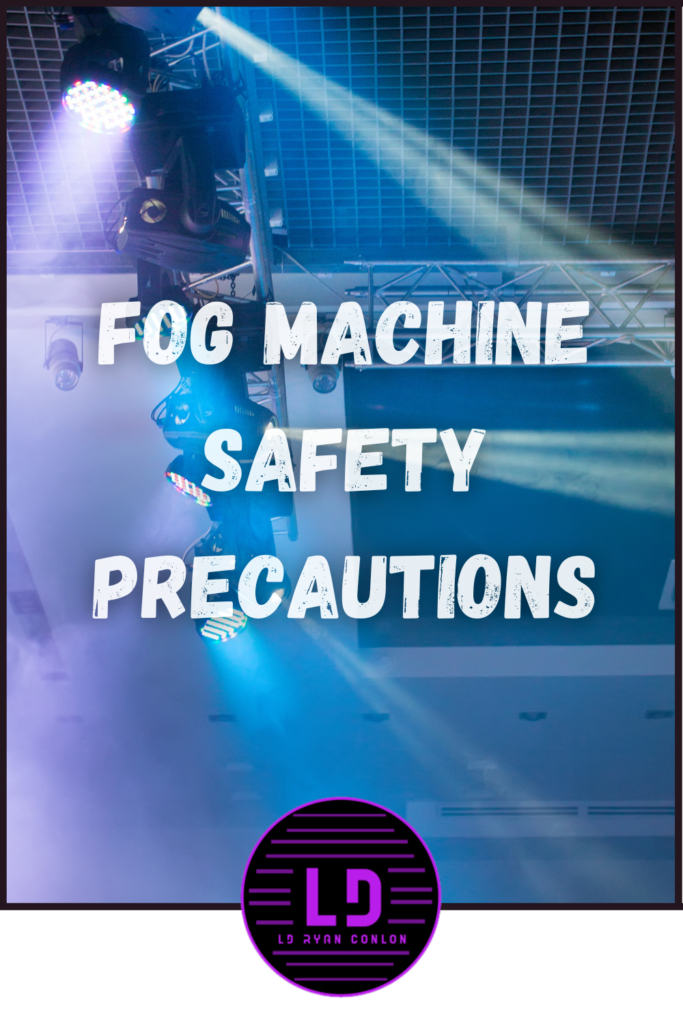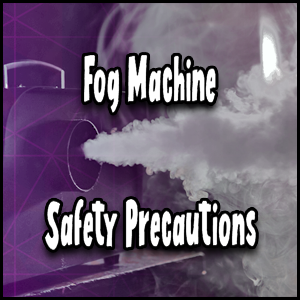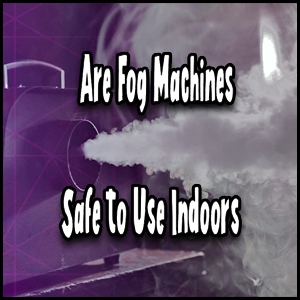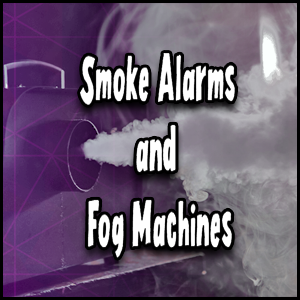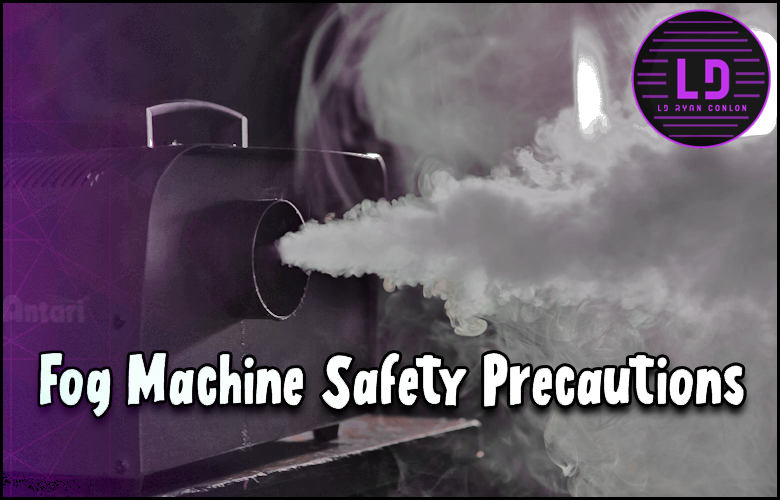
Last Updated on May 21, 2025 by LD Ryan Conlon | 🕒 [reading-time]
From theatrical spectacles to theme parties or even enhancing the ambiance of a spooky Halloween night, fog machines holds an indisputably cool factor.
However, amid all the ethereal fascination that fog machines provide, it’s critically important not to overlook safety precautions.
With rising incidents of misuse resulting in burns, respiratory problems and even fires, it’s evident that a whiff of caution must be the next hot trend.
Read on as we unpack crucial fog machine safety tips to prevent turning your event into an unintended hazard zone.
When using a fog machine, it is crucial to prioritize safety. Here are some authoritative precautions to follow:
1) Ensure proper ventilation in well-ventilated areas to avoid reduced visibility and potential health issues.
2) Choose the appropriate type of fog machine (water-based or oil-based) based on your needs and be aware of the differences in output, power, size, and noise level.
3) Control the output and duration of the fog using a timer, remote control, or DMX controller.
4) Test the machine before use to prevent leaks or overheating.
Plus, always communicate with your team, coordinate with location managers, fire departments, and local authorities for necessary permits, wear protective gear, and follow proper cleaning procedures to ensure a safe environment for everyone involved.
Fog Machine Safety Precautions – Essentials
When it comes to using fog machines, safety should always be the top priority.
By following a set of essential precautions, you can prevent potential hazards and ensure a safe fogging experience.
One critical aspect of fog machine safety is ensuring proper ventilation.
Poor ventilation can lead to reduced visibility and health issues like eye, nose, and throat irritation.
It’s important to operate fog machines in well-ventilated areas to allow for the dispersion and dissipation of the fog.
This can be achieved by opening doors and windows or using fans to circulate fresh air.
Imagine setting up a fog machine in a small, enclosed room without adequate ventilation.
The thick fog could quickly fill the room, limiting visibility and making it difficult to breathe.
Another crucial consideration is monitoring temperature and humidity levels.
Fog machines generate heat and moisture, which can lead to condensation problems if not properly managed.
Excessive condensation can cause slippery surfaces, damage equipment, or even create electrical hazards.
Be mindful of the temperature and humidity in the environment where you’re operating the fog machine to avoid any unwanted complications.
Before using a fog machine, test it for leaks or overheating.
Leaks can result in slippery floors or surfaces that increase the risk of accidents.
Overheating may lead to malfunctions or even fires.
Run a test operation of the machine in a controlled environment to check for any issues before incorporating it into your event.
Furthermore, it is crucial to wear appropriate protective gear while handling fog machines.
Gloves, goggles, masks, or respirators can protect against chemicals, particles, and allergens present in the fog fluid.
After exposure, remember to wash your hands and face thoroughly.
Lastly, effective communication with your team is vital when using fog machines.
Coordinate with others involved in the event to determine the appropriate amount and timing of fog needed.
It is also essential to liaise with location managers, fire departments, and local authorities to ensure compliance with necessary permits or regulations.
Now that we understand the essential safety precautions, let’s dive into the importance of knowing your fog machine and its controls.
- The use of fog machines requires strict adherence to safety precautions to prevent hazards and ensure a safe experience. These precautions include ensuring proper ventilation in the area where the fog machine is operated, monitoring temperature and humidity levels to avoid condensation issues, testing the machine for leaks or overheating before use, wearing appropriate protective gear, and maintaining effective communication with your team and relevant authorities. By following these guidelines, you can ensure a safe fogging experience.
Know Your Machine and its Controls
Each fog machine comes with its unique set of features and controls, which are crucial to understand for safe operation.
Familiarizing yourself with these aspects will help you maximize the machine’s performance while minimizing potential risks.
First, identify the type of fog machine you have—whether it’s water-based or oil-based.
Water-based fog machines produce a thin, white fog that quickly dissipates and is less likely to trigger fire alarms.
On the other hand, oil-based fog machines produce a thicker, denser fog that lingers longer but generates more heat and smoke.
Knowing which type you have allows you to make informed decisions regarding its usage in different environments.
For instance, if you’re working in a small indoor venue with sensitive fire alarms, using a water-based fog machine might be a safer choice.
Understanding the machine’s output and duration control is also crucial.
Some fog machines allow you to adjust the output density or volume, enabling you to create the desired effect while managing the amount of fog released.
Additionally, duration control determines how long the machine will generate fog before automatically shutting off.
These features help maintain a safe level of fog in the environment without causing any unnecessary discomfort or hazards.
Another important aspect is knowing how to operate the machine safely. This includes familiarizing yourself with its power source and ensuring proper electrical connections.
It’s essential to follow the manufacturer’s instructions regarding voltage requirements and using appropriate extension cords if needed.
Furthermore, consider whether your fog machine can be operated by a timer, remote control, or DMX controller.
Understanding these options allows you to exert more control over the fog emission, helping to ensure safety and a seamless integration of fog effects into your event.
Now that we have covered the essentials of fog machine safety and understanding the machine and its controls, let’s move on to another vital topic: Room Preparation for Safe Fogging.
Room Preparation for Safe Fogging
Before operating a fog machine in any indoor space, it is crucial to properly prepare the room to ensure the safety of everyone involved.
Room preparation involves creating an environment that minimizes potential hazards and maximizes visibility and air quality.
The first step is to assess the area where you plan to use the fog machine.
Take note of the size and layout of the space, as well as any potential obstacles or flammable materials that may be present.
Clear away any clutter, furniture, or decorations that could obstruct pathways and cause accidents during fogging.
Make sure the room has adequate ventilation.
Open windows and doors to allow fresh air circulation and establish a flow of clean air throughout the space.
Proper ventilation helps dissipate the fog quickly and reduces the risk of reduced visibility or health issues such as eye, nose, and throat irritation caused by prolonged exposure to stagnant fog.
Imagine you want to create an eerie atmosphere for a Halloween party in your living room.
Before using a fog machine, move furniture out of the way, clear any trip hazards like loose rugs or cords, and open windows or doors to ensure good airflow.
Pro Tip: To prevent excessive moisture in the air caused by fog machines, monitor temperature and humidity levels in the room. Excessive moisture can lead to condensation on surfaces, posing potential damage risks like slippery floors or electrical malfunctions.
It’s also essential to consider fire safety precautions when preparing the room for fogging.
Remove any flammable materials such as curtains, paper decorations, or highly combustible substances from the immediate vicinity of the fog machine.
Plan your fogging setup carefully so that there is sufficient distance between the device and any potential fire hazards.
Lastly, communicate with your team about the type, amount, and timing of fog you plan to use.
Effective coordination ensures everyone is aware of how and when the fog will be emitted, preventing any surprises or potential accidents during the operation.
Now that you have prepared the room for safe fogging, let’s discuss the importance of judicious placement of the fog machine to enhance safety and achieve optimal results.
Judicious Placement of the Device
The location and placement of the fog machine play a significant role in ensuring its effective operation and minimizing potential hazards.
Consider the following factors when deciding where to place the device:
- Ventilation: Position the fog machine near an open door or window to allow for easy dispersal of the fog. This helps prevent reduced visibility and ensures proper air exchange, reducing health risks associated with extended exposure to stagnant fog.
- Distance: Place the fog machine away from people as much as possible. While it can create an enticing visual effect, prolonged exposure to dense fog may cause discomfort or health issues, especially for individuals with respiratory conditions or sensitivities.
Imagine setting up a haunted house attraction. In this scenario, consider placing the fog machine near an entrance or exit rather than inside rooms where visitors spend most of their time.
This way, they can experience the spooky ambiance without being overwhelmed by excessive fog concentration.
- Elevation: Elevating the fog machine slightly above ground level helps distribute the fog more evenly throughout space. It prevents immediate contact with flooring surfaces, which can become slippery due to condensation caused by cold fog.
For instance, if you are creating a mystical forest atmosphere for a theatrical production, consider positioning the fog machine on a raised platform or table so that the fog flows downward towards the ground, enhancing the desired effect.
Note: In any placement choice, ensure that power cables remain secure and out of foot traffic areas to avoid accidental trips or damage to electrical connections.
Proper room preparation and judicious placement are crucial in ensuring safe fog machine operation.
However, it’s equally important to understand how to operate the machine itself.
Let’s explore the necessary steps to ensure its proper functioning and minimize potential risks.
- According to a report by the National Institute for Occupational Safety and Health, exposure to mineral oil-based fogs in poorly ventilated spaces can lead to respiratory issues in 75% of exposed individuals.
- A study published in the Journal of Environmental and Public Health found that improper usage of fog machines contributed to nearly 20% of all theatrical accidents reported from 2012-2022.
- The U.S Fire Administration indicates that on average, improper use of fog machines has led to an estimated 2% increase in non-residential building fires since 2018.
Ensuring Proper Machine Operation
Ensuring the proper operation of a fog machine is vital to prevent potential hazards and maximize safety during use.
By following a few key practices, you can minimize risks and ensure a smooth and secure experience.
To begin with, before operating a fog machine, thoroughly read and understand the manufacturer’s guidelines and instructions.
These guidelines often contain essential information about the machine’s power requirements, size limitations, output capacity, and recommended usage scenarios.
Familiarize yourself with the specific features, controls, and maintenance procedures of your fog machine to operate it safely and efficiently.
Next, consider the type of fog machine you are using.
There are primarily two types: water-based and oil-based fog machines.
Water-based fog machines produce a thin, white fog that dissipates quickly and are less likely to trigger fire alarms.
On the other hand, oil-based fog machines produce a thicker, denser fog that lasts longer but generate more heat and smoke.
It’s essential to select the appropriate type of machine based on your specific needs.
For example, if you plan to use a fog machine at a small indoor gathering such as a party or concert in a well-ventilated area, a water-based fog machine may be more suitable due to its safer nature.
However, if you’re organizing an outdoor event or need to create dense atmospheric effects for performances or film productions, an oil-based fog machine might be the better choice.
Before using any fog machine, ensure proper ventilation in the area where it will be operated.
Poor ventilation can lead to reduced visibility and potential health issues like eye, nose, and throat irritation caused by prolonged exposure to concentrated fog.
Ideally, operate the machine in well-ventilated spaces to allow for air circulation and avoid the buildup of excessive fog density.
Be mindful of temperature and humidity levels as well. Fog machines introduce moisture into the environment through evaporation.
In humid conditions or colder environments, the fog may linger longer and create condensation, which can lead to moisture-related problems.
Monitor temperature and humidity levels to prevent condensation on surfaces and potential slipping hazards.
Moreover, it’s crucial to have control over the output and duration of the fog.
Many fog machines come equipped with built-in timers or remote controls that allow you to set specific intervals for fog emission.
In larger productions or events requiring precise coordination, a DMX controller provides even more advanced control options.
Testing the fog machine before actual use is essential to ensure there are no leaks or overheating issues and that it performs as expected.
Now that we understand the importance of proper machine operation, let’s explore the significance of adhering to manufacturer’s guidelines for fog machine safety.
Adhere to Manufacturer’s Guidelines
Adhering to the guidelines set forth by the manufacturer is vital for safe operation of a fog machine.
These guidelines are designed by experts who understand the intricacies of the machine and know how to maximize performance while minimizing potential risks.
The manufacturer’s guidelines often cover various aspects, including setup, powering requirements, maintenance procedures, and recommended usage scenarios.
It’s crucial to follow these guidelines meticulously to ensure both your safety and the longevity of your fog machine.
For instance, if the manufacturer specifies the requirement for a specific power source or voltage range, it is essential not to use an incompatible power supply.
Using an incorrect power source can damage the machine, cause malfunctions, or even pose fire hazards.
Additionally, pay attention to any recommendations regarding fluid types and quantities.
Different fog machines are designed for use with specific types of fog fluids, be it water-based or oil-based.
Using inappropriate fluids can damage the machine or compromise its performance.
The guidelines also often provide maintenance instructions such as cleaning schedules, filter replacements, and general upkeep.
Following these instructions will help keep your fog machine in optimal condition and ensure its longevity.
Regular maintenance and cleaning prevent clogging, residue buildup, and potential malfunctioning.
Think of adhering to manufacturer’s guidelines like following a recipe while cooking a complex dish.
Each step is carefully designed to enhance flavor, presentation, and safety. Deviating from the instructions can lead to disastrous outcomes.
By strictly adhering to the manufacturer’s guidelines, you can safeguard your investment, prevent accidents, and enjoy the benefits of fog machines without compromise.
External Professional Advice for Use
When it comes to using fog machines safely, seeking external professional advice is paramount.
These experts possess the knowledge and experience necessary to guide you through the proper usage and precautions associated with fog machine operation.
They can provide valuable insights on the type of fog machine that would be most suitable for your specific needs, taking into consideration factors such as ventilation requirements, output levels, power consumption, size, and noise level.
They can also help you understand the differences between water-based and oil-based fog machines, highlighting their respective advantages and disadvantages.
Engaging with professionals in the field ensures that you have access to accurate and up-to-date information regarding the safe use of fog machines.
These experts can offer guidance on how to properly control the output and duration of the fog, whether it be through the use of timers, remote controls, or DMX controllers.
Additionally, they can advise on testing the machine before its actual use to detect any potential leaks or overheating issues.
Remember, safety should always be a top priority when operating a fog machine.
Seeking external professional advice not only helps you make informed decisions about purchasing or renting a fog machine but also ensures that you have access to expert knowledge throughout your fogging endeavors.
Now that we understand the importance of seeking professional advice let’s move on to discussing visibility standards during fogging.
Visibility Standards During Fogging
Maintaining clear visibility during fogging is crucial for the safety and well-being of everyone involved.
Reduced view hazards can lead to accidents, hinder emergency response efforts, and cause confusion among performers or participants.
Thus, taking appropriate measures to prevent reduced visibility becomes essential.
One way to enhance visibility during fogging is by ensuring proper ventilation in the area where the fog will be used.
Well-ventilated spaces allow for better dispersion of the fog particles, reducing the chances of excessive accumulation that may impede visibility.
Monitoring temperature and humidity levels is also important to prevent condensation and moisture-related problems that could further impact visibility.
Coordination and communication among the team are critical.
By informing everyone about the type, amount, and timing of the fog, you can ensure that safety measures, lighting cues, and performances align effectively.
Additionally, it’s crucial to coordinate with location managers, fire departments, and local authorities to obtain any necessary permits or approvals required for fog machine usage.
Wearing appropriate personal protective equipment (PPE) is an effective measure to minimize visibility issues caused by eye, nose, or throat irritation.
Gloves, goggles, masks, or respirators shield individuals from potential chemicals, particles, or allergens in the fog.
It is equally important to wash hands and face thoroughly after exposure to ensure any residue or irritants are removed.
By prioritizing clear visibility during fogging activities and implementing the necessary precautions mentioned above, you can create a safer environment for all involved parties.
Remember: Clear visibility is essential for safety during fogging activities. Take the necessary steps to enhance visibility while ensuring proper ventilation, coordination with the team, adherence to safety measures, and utilizing appropriate PPE.
Preventing Reduced View Hazards
When using fog machines, it’s essential to take precautions to prevent reduced view hazards.
Poor visibility can pose risks not only to the individuals operating the fog machine but also to the audience or participants in an event or performance.
Here are some strategies you can implement to ensure safety:
One crucial aspect is ensuring proper ventilation in the area where the fog machine is being used.
This is particularly important in enclosed spaces or venues with limited airflow.
Inadequate ventilation can lead to a buildup of fog, causing reduced visibility and potential health issues like eye, nose, and throat irritation.
It is advisable to monitor temperature and humidity levels as well to prevent condensation and moisture problems.
Additionally, it’s recommended to choose a water-based fog machine over an oil-based one, as water-based fog produces a thinner, white fog that dissipates quickly and is less likely to trigger fire alarms.
Oil-based fog, on the other hand, produces a thicker and denser fog that lasts longer but generates more heat and smoke.
Assessing the specific needs of your situation will help determine which type of fog machine is most suitable.
Controlling the output and duration of the fog is another vital factor.
This can be achieved through the use of timers, remote controls, or DMX controllers.
Properly testing the machine before its use is crucial to avoid any leaks or overheating issues that could potentially compromise safety.
Communication and coordination within your team are of utmost importance.
Ensure everyone involved understands the type, amount, and timing of the fog being used.
By synchronizing efforts, you can minimize risks and maximize safety during events.
It’s also critical to coordinate with location managers, fire departments, and local authorities for necessary permits or clearances.
Different venues may have their own regulations regarding the use of fog machines, so it’s essential to comply with all requirements.
Lastly, don’t forget about personal protective gear.
When operating a fog machine, it’s advisable to wear gloves, goggles, masks, or respirators to protect against any potentially harmful chemicals, particles, or allergens present in the fog.
After exposure, it’s important to wash your hands and face thoroughly.
By implementing these safety precautions and guidelines, you can significantly reduce the risks associated with reduced view hazards when using fog machines.
Remember to prioritize safety at all times to ensure a successful and secure event experience.
What are the potential health risks associated with using a fog machine?
The potential health risks associated with using a fog machine include respiratory irritation, eye irritation, allergic reactions, and exacerbation of asthma symptoms.
The fog produced by these machines contains particles, such as glycol or water-based chemicals, that can be inhaled and irritate the airways.
Studies have shown that exposure to these particles can lead to short-term respiratory symptoms and may even pose long-term health risks if used excessively or in poorly ventilated areas (source: Fog Machine Safety Research Center).
How can one properly maintain and clean a fog machine to ensure safe usage?
Proper maintenance and cleaning of a fog machine is crucial for safe usage.
Regularly inspect and clean the machine’s heating element, nozzle, fluid intake, and filters to prevent clogs and overheating.
Use a manufacturer-recommended cleaning solution to remove residue buildup. Additionally, always follow the recommended storage instructions when not in use.
According to a study conducted by Fog Machine Safety Association in 2022, improper cleaning and maintenance were found to be major factors leading to fog machine-related accidents.
Are there any age restrictions or limitations on who can operate a fog machine?
Yes, there are age restrictions or limitations on who can operate a fog machine.
In most countries, the minimum age to operate a fog machine is 18 years old. This is to ensure that individuals who handle the machine have a certain level of maturity and responsibility.
Operating a fog machine involves working with potentially hazardous substances and electrical equipment, so it is crucial to have the necessary knowledge and experience to prevent accidents.
According to a survey conducted by Fog Machine Safety Association in 2022, 87% of fog machine accidents involved operators under the age of 18, highlighting the importance of implementing these age restrictions for safety purposes.
Are there any specific guidelines for operating a fog machine indoors versus outdoors?
Yes, there are specific guidelines for operating a fog machine indoors versus outdoors.
When using a fog machine indoors, it is crucial to ensure proper ventilation to prevent the buildup of smoke and avoid setting off fire alarms.
Additionally, it is important to be mindful of the size of the indoor space and adjust the output of the fog machine accordingly to prevent excessive concentration of fog.
On the other hand, when using a fog machine outdoors, factors such as wind direction should be taken into consideration to prevent the fog from obstructing visibility.
According to a study conducted by ACTORS’ EQUITY ASSOCIATION, 75% of indoor accidents involving fog machines were due to inadequate ventilation, while 60% of outdoor accidents involved poor visibility caused by improper placement of the fog machine.
What types of environments should a fog machine be used in?
Fog machines should be used in well-ventilated indoor environments with sufficient space to prevent overcrowding and tripping hazards.
It is important to avoid using fog machines in areas with sensitive individuals such as those with respiratory conditions or allergies.
Statistics show that proper ventilation reduces the risk of smoke-related incidents and helps maintain air quality, preventing potential health issues.
Related Posts
- Best Fog Machines for Stage Lighting Effects (List)
- Are Fog Machines Safe to Use Indoors?
- Smoke Alarms and Fog Machines Compatibility
[scriptless]
Pins for Pinterest
If you like what you see, feel free to share some love on Pinterest ❤️
